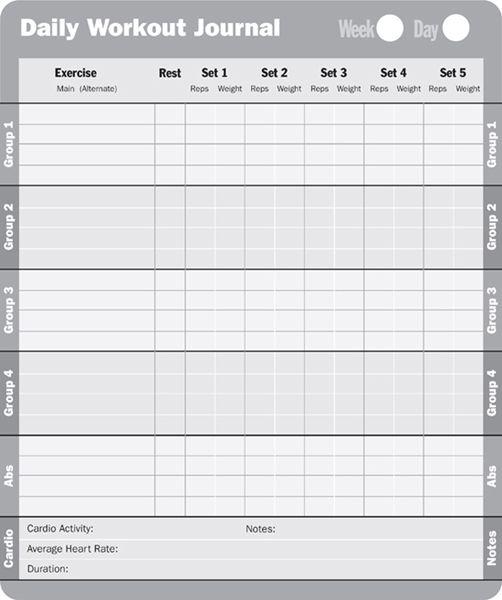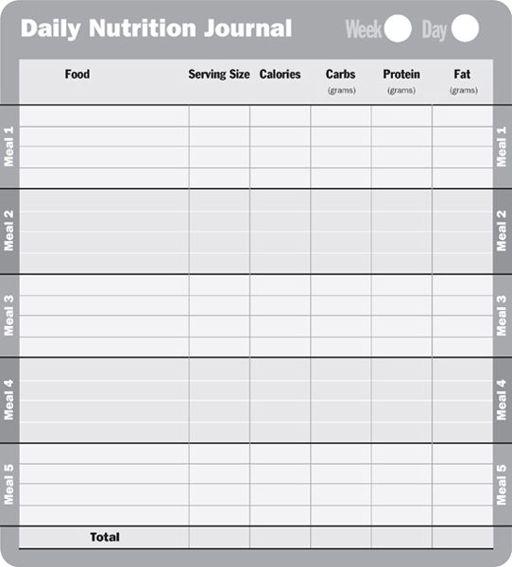The Body Sculpting Bible for Women (126 page)
Read The Body Sculpting Bible for Women Online
Authors: James Villepigue,Hugo Rivera
Tags: #Health & Fitness, #Exercise, #General, #Women's Health

14-DAY RAPID BODY SCULPTING WORKOUT #2
14-DAY ADVANCED BODY SCULPTING WORKOUT #1
14-DAY ADVANCED BODY SCULPTING WORKOUT #2
14-DAY BODY SCULPTING DEFINITION WORKOUT
14-DAY BODYWEIGHT BODY SCULPTING WORKOUT
Appendix E
Nutrition Journal
Appendix F
Tracking Your Progress
The only way to know if your program is working is to track your progress. A simple way to do this is by using the following formulas excerpted from the book Hardcore Bodybuilding: A Scientific Approach, written by strength training authority Frederick C. Hatfield, Ph.D. Dr. Hatfield, better known as Dr. Squat, is the co-founding Director of Sports and Fitness Sciences for the prestigious International Sports Sciences Association (ISSA). As a three-time winner of the World Championship of Powerlifting, Dr. Hatfield not only is well versed on weight training theory, but on its application as well.
FOR WOMEN:
Before you use the formulas, there are five measurements required:
| Measurement 1: | | Body weight. |
| Measurement 2: | | Wrist Circumference (measured at the widest point). |
| Measurement 3: | | Waist Circumference (measured at your umbilicus). |
| Measurement 4: | | Hip Circumference (measured at the widest point). |
| Measurement 5: | | Forearm Circumference (measured at the widest point). |
PROCEDURE:
| #1- | | Multiply your body weight by 0.732. Body weight × 0.732 = Result 1. |
| #2- | | Add the result above to 8.987. → Result 1 + 8.987 = Result 2. |
| #3- | | Divide your wrist circumference by 3.14. → Wrist divided by 3.14 = Result 3. |
| #4- | | Multiply your waist measurement by 0.157. → Waist × 0.157 = Result 4. |
| #5- | | Multiply your hip measurement by 0.249. → Hip × 0.249 = Result 5. |
| #6- | | Multiply your forearm measurement by 0.434. → Forearm × 0.434 = Result 6. |
| #7- | | Add results 2 and 3. → Result 2 + Result 3 = Result 7. |
| #8- | | Subtract Result 4 from Result 7. → Result 7 - Result 4 = Result 8. |
| #9- | | Subtract Result 5 from Result 8. → Result 8 - Result 5 = Result 9. |
| #10- | | Add Result 6 and Result 9. The result is your Lean Body Mass (your fat-free weight) → Result 6 + Result 9 = Lean Body Mass. |
| #11- | | Subtract your Lean Body Mass from your body weight. Once you get the result, multiply that number by 100. Once you get this result, divide it by your Body weight. → [(Body weight-Lean Body Mass) × 100] divided by your body weight. |
EXAMPLE:
A woman that weighs 125 and has a wrist measurement of 6.0, a waist measurement of 24, a hip measurement of 38, and a forearm measurement of 9.5 would calculate her body fat percentage in the following manner.
| Step 1: | | 125 × 0.732 = 91.5. |
| Step 2: | | 91.5 + 8.987 = 100.487. |
| Step 3: | | 6 divided by 3.14 = 1.91. |
| Step 4: | | 24 × 0.157 = 3.768. |
| Step 5: | | 38 × 0.249 = 9.462. |
| Step 6: | | 9.5 × 0.434 = 4.123. |
| Step 7: | | 100.487 + 1.91 = 102.397. |
| Step 8: | | 102.397 - 3.768 = 98.629. |
| Step 9: | | 98.629 - 9.462 = 89.167. |
| Step 10: | | 4.123 + 89.167 = 93.29 (Lean Body Weight: Fat-Free Weight). |
| Step 11: | | [(125-93.29) × 100] divided by 125 = (31.37 × 100) divided by 125 = 3171 divided by 125 = 25.368 (Body Fat Percentage). |
Notes:
The formulas above are approximations. The goal is to have a point of reference from which to work. I recommend that you measure your body fat every three weeks. If you see a pattern of gaining muscle and losing fat, then you know your program is on track. If not, examine which part of your program is not optimal. Assuming that you are following the recommended training routines, the only things that could be going wrong are either you are not getting enough rest at night, or more likely, are not following the nutrition plan properly.
Appendix G
Grocery Shopping List
Note:
Eat a meal prior to going grocery shopping to ensure that you don’t buy junk foods. Another strategy is to do your grocery shopping on Sundays, when you are allowed to eat whatever you want for one meal.
Obviously, you do not need to purchase all of the items on this grocery list. We provide it as a reminder of the types of foods that your shopping list should include.
CARBOHYDRATES
Brown rice
Chickpeas
Cream of rice
Yams (sweet potatoes)
Whole wheat bread
Plain oatmeal (old fashion, not instant)
Corn
Baking potato
Pita bread
Lentils
Grits
Fruits
Fresh green vegetables
PROTEINS
Chicken breasts (avoid deli meats; they are high in sodium and low in protein)
Turkey breasts (avoid deli meats; they are high in sodium and low in protein)
Water-packed Tuna
White fish
Eggs
Halibut
Cod
Round steak
Top sirloin
FATS
Flaxseed Oil
SUPPLEMENTS
Vitamin and mineral formula
Vitamin C
Chromium picolinate
Fish oil capsules (if you don’t use flaxseed oil)
Meal replacement powders
Whey protein powders
Protein bars
Creatine
Glutamine
DAIRY
Skim Milk
MISCELLANEOUS ITEMS
Garlic powder (for flavoring)
Onion powder (for flavoring)
Balsamic vinegar
Crystal light
Any sugar-free and salt-free seasoning
(Photocopy these pages for your own personal use)
Appendix H
Body Sculpting Under Special Circumstances


